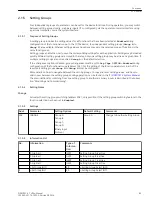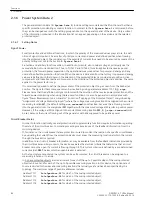
Further 1-phase Protection Functions
The 1-phase protection functions evaluate the 1-phase measuring current of 1-phase additional measuring
input. It is irrelevant in this context whether the connect current belongs to the main protected object or not.
Only the current connected to the additional measuring input is decisive.
The device must now be informed which current is to be evaluated by the 1-phase protection functions.
Address 424
DMT/IDMT E AT
assigns the time overcurrent protection for earth current (Section
Overcurrent Protection for Earth Current
) to a 1-phase additional measuring input. In most cases this will be
the current flowing in the neutral leads of an earthed winding, measured between the starpoint and the earth
electrode. In
, the auxiliary measuring location X3 would be a good choice; so you set here
Auxil-
iaryCT IX3
. As this protection function is autonomous, i.e. independent of any other protection function,
any 1-phase additional measuring input can be used. This requires, however, that it is not a high-sensitive
measuring input and, of course, that it is connected. Please note also that the earth overcurrent protection will
receive from the auxiliary measuring location assigned here not only its measured value, but also circuit
breaker information (current flow and manual-close detection).
The second earth overcurrent protection can be assigned to another single-phase measuring location
according to the same aspects under address 438
DMT/IDMT E2 AT
.
Address 427
DMT 1PHASE AT
assigns the single-phase time overcurrent protection (Section
). This protection function is mainly used for high-sensitivity current measure-
ment, e.g. for tank leakage protection or high-impedance differential protection. Therefore a high-sensitivity
1-phase additional measuring input is particularly suited for it. In
this would be the auxiliary meas-
uring location X4; so you set this address to
AuxiliaryCT IX4
. However, it is also possible to assign this
protection function to any other additional measuring input used, regardless of its sensitivity.
Circuit Breaker Data
Circuit Breaker Status
Various protection and ancillary functions require information on the status of the circuit breaker for faultless
operation. Command processing makes also use of the feedback information from the switching devices.
If, for instance, the circuit breaker failure protection is used to monitor the reaction of a specific circuit breaker
(CB), the protection device must know the measuring location at which the current flowing through the
breaker is acquired, and the binary inputs which provide information on the breaker status. During the config-
uration of the binary inputs you merely assigned the (physical) binary inputs to the (logic) functions. The
device, however, must also know to which measuring location(s) the circuit breaker is assigned.
The breaker failure protection — and thus the circuit breaker that is monitored by it — is normally assigned to
a measuring location or to a side (see above, under margin heading “Further 3-Phase Protection Functions”).
You can therefore set addresses 831 to 835
SwitchgCBaux S1
to
SwitchgCBaux S5
if a side is concerned,
or addresses 836 to 840
SwitchgCBaux M1
to
SwitchgCBaux M5
if a measuring location is concerned.
You can, alternatively, monitor any desired circuit breaker, exclusively by means of the CB position indication,
i.e. without consideration of current flow. In this case you must have selected under address 470
BREAKER
FAIL.AT
=
Ext. switchg. 1
. You have then to select the corresponding breaker feedback information
under address 841
SwitchgCBaux E1
(switching device auxiliary contact of external breaker).
Select the address which corresponds to the assignment of the circuit breaker failure protection. There, you
choose from the following options:
•
If during the configuration of the binary inputs you have defined the circuit breaker as a control object,
and allocated the appropriate feedback indications, you choose these feedback indications to determine
the circuit breaker position, e.g.
Q0
. The breaker position is then automatically derived from the circuit
breaker Q0.
•
If during the configuration of the binary inputs you have generated a single-point indication which is
controlled by the NC or NO auxiliary contacts of the circuit breaker, you select this indication.
•
If during the configuration of the binary inputs you have generated a double indication which is
controlled by the NC or NO auxiliary contact of the circuit breaker (feedback from the protected object),
you select this indication.
•
If you have generated appropriate indications using CFC, you can select these indications.
2.1.4.4
Functions
2.1 General
SIPROTEC 4, 7UT6x, Manual
71
C53000-G1176-C230-5, Edition 09.2016
Содержание SIPROTEC 4 7UT6 Series
Страница 394: ...394 SIPROTEC 4 7UT6x Manual C53000 G1176 C230 5 Edition 09 2016 ...
Страница 482: ...482 SIPROTEC 4 7UT6x Manual C53000 G1176 C230 5 Edition 09 2016 ...
Страница 504: ...504 SIPROTEC 4 7UT6x Manual C53000 G1176 C230 5 Edition 09 2016 ...
Страница 522: ...522 SIPROTEC 4 7UT6x Manual C53000 G1176 C230 5 Edition 09 2016 ...
Страница 528: ...528 SIPROTEC 4 7UT6x Manual C53000 G1176 C230 5 Edition 09 2016 ...
Страница 538: ...538 SIPROTEC 4 7UT6x Manual C53000 G1176 C230 5 Edition 09 2016 ...
Страница 664: ...664 SIPROTEC 4 7UT6x Manual C53000 G1176 C230 5 Edition 09 2016 ...
Страница 666: ...666 SIPROTEC 4 7UT6x Manual C53000 G1176 C230 5 Edition 09 2016 ...
Страница 683: ...Z Zero sequence currents 109 Index SIPROTEC 4 7UT6x Manual 683 C53000 G1176 C230 5 Edition 09 2016 ...
Страница 684: ...684 SIPROTEC 4 7UT6x Manual C53000 G1176 C230 5 Edition 09 2016 ...






























